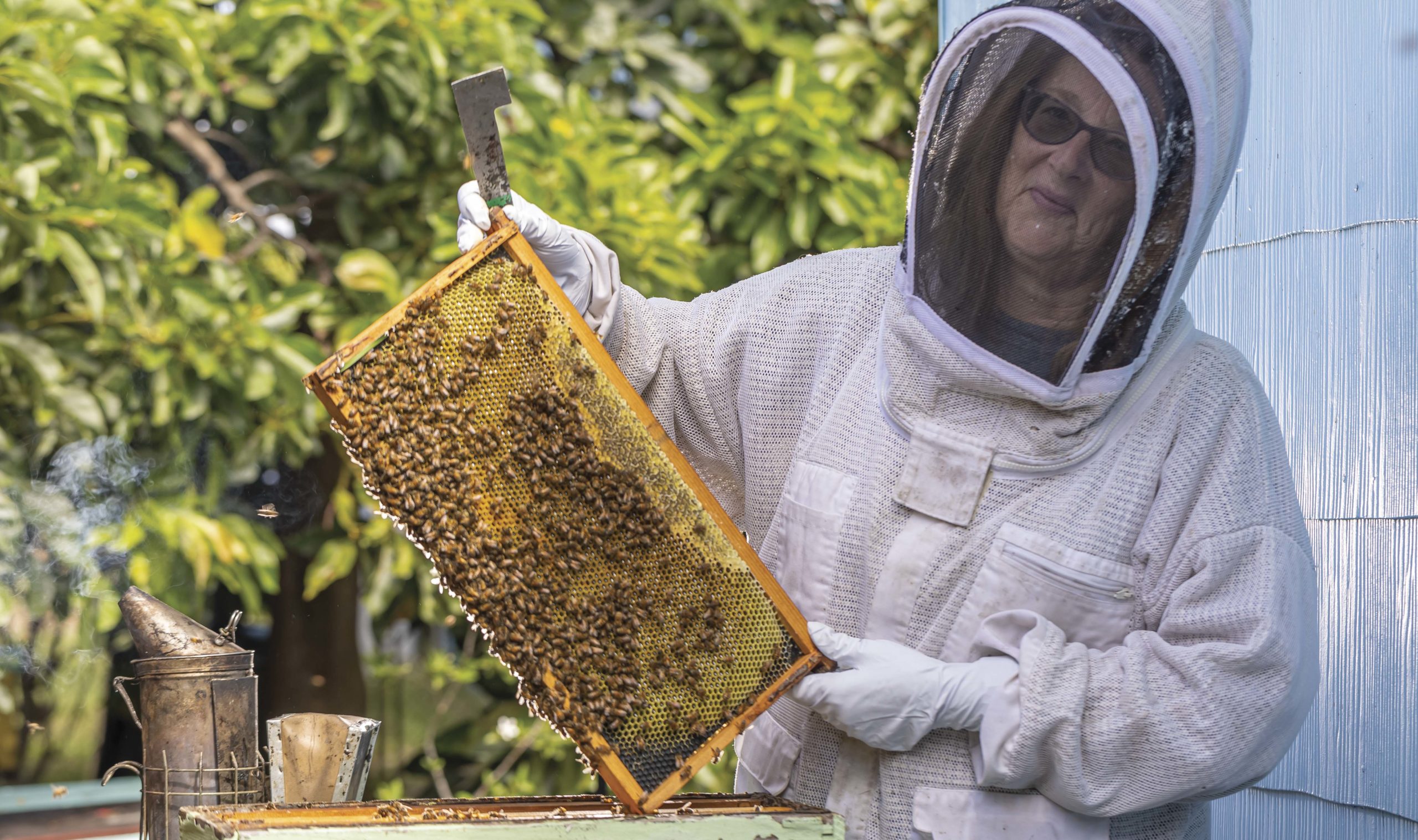For Becky Dineen, a corporate career was no match for the pull of passion. It was a chance encounter along the roadside that inspired her to trade in her business suit for a beekeeping suit. She’ll bve the first to say that her old coworkers in the banking and sales industry are no match for the new ones – her husband, Art Howe, and their Italian honeybees.
Her journey to the hives began in 2015. Driving past a roadside stand, an assortment of 12-ounce bear-shaped containers of honey caught Dineen’s eye. She made a giant U-turn and went to explore. At this humble stand, she found honey that was harvested just miles from her home and more importantly, Charlie Mertz, a beekeeper and honey harvester who would become her beekeeping mentor.
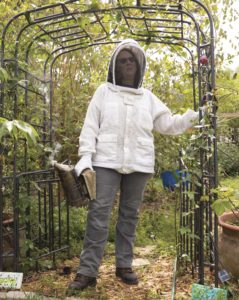
Mertz invited her to a Pinellas Beekeepers Association meeting and then to his home to learn the language of the honeybee. Atop his roof, she worked her first hives, learning, harvesting and bumbling into the garage each time the bees developed a temper.
“I figured I was intruding on their homes and they were being protective,” she reflects. “I realize now that not all honeybees are created equal.”
It didn’t take long for Dineen to be elected treasurer, then vice president of the local club.
“I was jumping right in and a few years later I took a job as a local bee inspector,” she says. “From my first hive, given by Charlie, I’ve now grown to about 130 hives.”
Dineen’s hives (structures for homing a swarm of honeybees) are kept at home, along with eight other apiaries throughout Pinellas County.
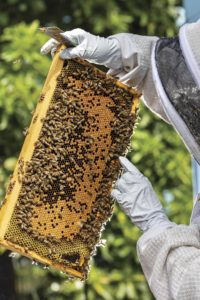
Dineen and her husband of 25 years, Howe, founded A Bee’s Place in 2015 to share local honey with the Tampa Bay community. It’s a perfect partnership – Dineen takes care of the bees and Howe, a retired upholsterer, harvests, bottles and sells the honey. He also helps in the apiaries, makes and fixes hive equipment and assists with educating others about bees.
With over 300 registered beekeepers in Pinellas County and over 250 in Hillsborough, Dineen loves being part of a community that isn’t just about selling honey, but rather, being responsible stewards of honeybee hives and caring for the bees.
“We also do safe bee removal,” she says. “We get lots of calls from homeowners who don’t want them killed.”
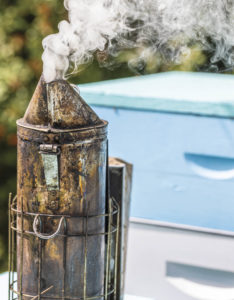
And, saving the bees is a worthy cause. Becky explained that the peregrinating pollinators are responsible for pollinating 80% of flowering plants. According to the USDA, one out of three bites of our food in the United States is created with the help of these pollinators.
She credits fellow bee enthusiast Mike Carnahan with teaching her how to do removals, which has allowed her to create loving homes for bees to thrive under care.
It is through bee removal and also the natural cycle of bee reproduction that Dineen’s hives multiply. For the swarm (reproduction) process, she keeps a close eye, careful that the swarming bees don’t leave in search of a new home.
“As beekeepers, part of our job is to do our best to catch the hive before it swarms (splits into two distinct colonies) by looking for an increase in drone population, queen cells and full capacity of bees in the hive box,” she explains. “When we find these things, we split the population or divide the box into two hives before the hive swarms. We also place swarm traps near our apiaries in case we miss this activity in hopes they will take up home in one of those.”
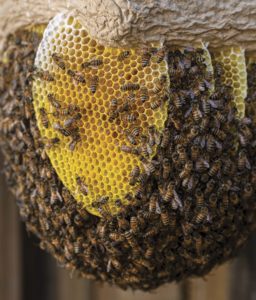
Sorting through the shelves of a store, many may not know how varied honey can be in flavor, dependent on the nectar that the bees feed on. But Dineen knows that many factors contribute to honey’s flavor and color, including region, season of the year and the bees’ food supply.
For example, Dineen periodically migrates her bees to orange groves, where the bees can forage for nectar from these plants and produce orange blossom honey with its distinct flavor – sweet, bright and floral with a hint of citrus as it dissolves on the tongue.
A Bee’s Place produces spring, summer and fall wildflower honey. Wildflowers are her bees’ main food source and each season’s honey has complex nuances in flavor.
“Spring honey is more floral – you can taste the aroma,” she describes. “Summer is darker. This year, I’m not sure what the bees got into, but the taste is earthy and not quite as sweet. During fall, the bees feasted on nectar from the Brazilian pepper tree, which is plentiful in our region. The result is a unique flavor, not peppery, but with a tang.”
At the end of each season, Howe bottles the honey at a commercial kitchen in St. Petersburg, then sells it through local retailers, area vendor markets and their online store.
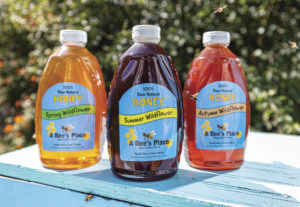
Supers (boxes added above the brood chamber, aka hive box, used to collect honey) are extracted from the brood chamber. Then the wax (covering the bees’ produce to seal the honey) is removed (uncapping) using a long knife. These frames are placed in a honey extractor, which uses centrifugal force to spin the frames. The process flings the honey outward and it’s immediately strained and bottled.
The duo only bottles excess honey, reserving a portion for the bees to continue to use in their hives.
“We want our bees to be happy,” Dineen says. “It’s been a labor of love. We got into it and continue to enjoy the journey. We’ve met other beekeepers, rescued bees, battled losing bees and we love being part of such a great local community that cares about bees.”
Beekeepers know, it’s happy bees and responsible beekeepers that create good honey.
“We should really be looking for raw, natural honey,” Dineen shares. “Some suppliers heat the honey over 100 degrees, which removes the beneficial factors, but makes it easier to pour. Many commercial honeys are altered with fructose, rice syrup and other ingredients.”
Found to be contaminated with illegal antibiotics and heavy metals, the United Kingdom recently banned the import of honey from China and India — and American beekeepers argue that it’s prudent to keep these polluted varieties off the shelves and out of people’s bodies.
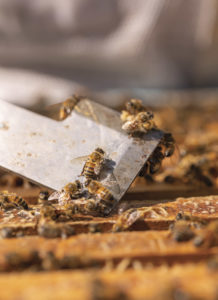
Health-conscious market Rollin Oats is one local retailer that carries Dineen’s honey, noting that more folks are looking for honey produced locally.
“It’s a product people like to have sourced locally for both taste and health benefits,” explains Phoebe Marinelli, Rollin Oats’ director of marketing. “We have actually seen some of the hives ourselves and know the love and passion that A Bee’s Place puts into both the care of their bees and the production of their honey.”
A Bee’s Place is part of the growing push toward community-supported agriculture, popping up in rural and urban neighborhoods alike throughout America. Local customer Julie Morris is just one example of consumers looking for food made near home.
“Finding a business that is passionate and knowledgeable on the production of honey was a true find,” she says. “I have been a customer of Becky and Art for many years and enjoy my visits to A Bee’s Place. I’m intrigued by the purity of the honey and the variety of flavors. Having a ‘smackerel’ of their honey is the highlight of my day.”
A recurring sentiment amongst customers of A Bee’s Place is that when you get honey from Dineen and Howe, you’re hooked. Donna and Bob Snyder have been loyal customers since moving to Tampa in 2015.
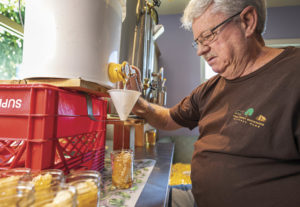
“We really love the subtle seasonal changes in the honey flavor due to the various seasonal plants their bees visit,” she notes. “They are passionate about their bees, their honey and their customers and when we see them we always have a delightful time.”
`As sweet as the bees can be and as passionate as she is personable, there are few like Dineen who appreciate the pulchritude of the gentle honeybee. Whether it’s home deliveries, offering up her favorite honey recipes or answering questions about beekeeping and honey production, she sees her role as an apiarist as an honor.
The byproduct — fresh, floral, fruity honey — is a credit to her care for healthy bees and happy, honey-filled people. Whatever flavor you try, the verdict is the same – the best honey seems to come from the happiest bees, which just might happen to be in Tampa Bay.
Inspired to be healthier? Check out 7 Habits of Highly Healthy People.


